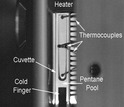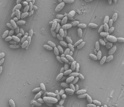Learning from fluids, in space

NSF and CASIS will send engineering projects into microgravity.
September 30, 2016
The National Science Foundation (NSF) has awarded $1.5 million for fundamental research in fluid dynamics to be performed on the International Space Station (ISS) U.S. National Laboratory for the benefit of life on Earth.
The five awards are made jointly with the Center for the Advancement of Science in Space (CASIS), which will manage operations for the experiments.
“We welcome the opportunity to support research onboard the ISS National Laboratory,” says Grace Wang, NSF acting assistant director for Engineering. “In the microgravity environment of space, NSF grantees will be able to investigate fluid dynamics phenomena and processes not observable on Earth -- to further our scientific understanding that will lead to advances to benefit all Americans.”
A variety of physical forces are at work any time particles and fluids interact. For very small particles, like those often used in semiconductor manufacturing, weak interactions are especially important. On Earth, gravity dominates. Researchers cannot simply remove gravity to study how the other forces affect fluid physics processes and phenomena.
“These are experiments that cannot be done here on Earth,” says Dimitrios Papavassiliou, who coordinated the new awards during his rotation as an NSF program officer. “On Earth, gravity is so strong that it overwhelms all the other processes, so we cannot observe the true, fundamental nature of fluid dynamics without this force. The ISS environment eliminates this factor to allow researchers to focus on the finer, weaker interactions.”
The findings from the NSF research onboard the IIS promise advances in manufacturing, oil and gas, electronics and photonics, drug delivery, microfluidics and many other areas.
The five projects are:
- Kinetics of nanoparticle self-assembly in directing fields, led by Eric Furst, University of Delaware
- Inertial Spreading and Imbibition of a Liquid Drop Through a Porous Surface, led by Michel Louge, Cornell University
- Quantifying Cohesive Sediment Dynamics for Advanced Environmental Modeling, led by Paolo Luzzatto-Fegiz, University of California, Santa Barbara
- Constrained Vapor Bubbles of Ideal Mixtures, led by Joel Plawsky, Rensselaer Polytechnic Institute
- Unmasking contact-line mobility for Inertial Spreading using Drop Vibration and Coalescence, led by Paul Steen, Cornell University
This research is funded through the fluid dynamics and particulate and multiphase processes programs of the NSF Division of Chemical, Bioengineering, Environmental and Transport Systems (CBET) in the Directorate for Engineering. CBET supports discoveries in chemical and biochemical systems; environmental engineering and sustainability; bioengineering and engineering healthcare; and fundamental transport, thermal and fluid phenomena.
-NSF-
Media Contacts
Sarah Bates, NSF, (703) 292-7738, sabates@nsf.gov
Patrick O’Neill, CASIS, (321) 480-1054, PONeill@iss-casis.org
Program Contacts
Ronald Joslin, NSF CBET, (703) 292-7030, rjoslin@nsf.gov
Related Websites
CASIS news release: http://www.iss-casis.org/NewsEvents/PressReleases/tabid/111/ArticleID/232/ArtMID/586/CASIS-and-the-National-Science-Foundation-Partner-to-Fund-15-Million-in-Fluid-Dynamics-Investigations.aspx
NSF/CASIS Collaboration on Fluid Dynamics Research on the International Space Station to Benefit Life on Earth program solicitation (NSF 16-518): https://www.nsf.gov/funding/pgm_summ.jsp?pims_id=505258
The U.S. National Science Foundation propels the nation forward by advancing fundamental research in all fields of science and engineering. NSF supports research and people by providing facilities, instruments and funding to support their ingenuity and sustain the U.S. as a global leader in research and innovation. With a fiscal year 2023 budget of $9.5 billion, NSF funds reach all 50 states through grants to nearly 2,000 colleges, universities and institutions. Each year, NSF receives more than 40,000 competitive proposals and makes about 11,000 new awards. Those awards include support for cooperative research with industry, Arctic and Antarctic research and operations, and U.S. participation in international scientific efforts.
Connect with us online
NSF website: nsf.gov
NSF News: nsf.gov/news
For News Media: nsf.gov/news/newsroom
Statistics: nsf.gov/statistics/
Awards database: nsf.gov/awardsearch/
Follow us on social
Twitter: twitter.com/NSF
Facebook: facebook.com/US.NSF
Instagram: instagram.com/nsfgov




